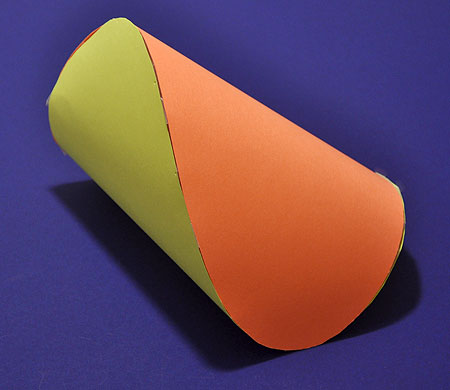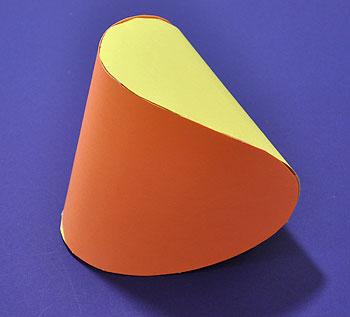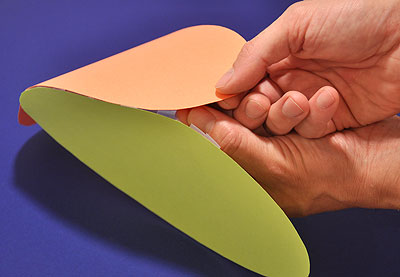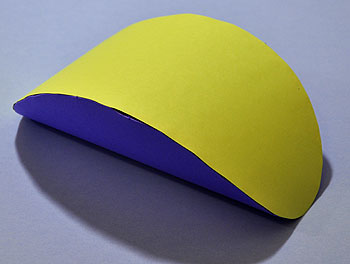D-Forms

If you line up two ellipses cut out of paper and tape the edges together, they lie flat. But if you give one ellipse a twist before you connect the edges, the ellipses bow outward to create this 3D form. Tony Wills invented this concept and named the shapes: D-Forms. The photograph above is the result of taping together the edges of two ellipses when one ellipse is rotated 45° with respect to the other. D-Forms aren't restricted to ellipses. You can experiment with any two shapes as long as they have the same perimeter.
Steps
- Cut out one ellipse with tabs and a second ellipse without tabs.
- Fold the tabs using a valley fold.
 Line up the vertex of one ellipse with some other spot on the circumference of the second ellipse. The shape above was made with the vertex of one ellipse connected to the spot marked 45° on the second ellipse. However, it doesn't matter which spot you choose because each starting point creates a different shape. The shape on the right was created with the the two ellipses at right angles.
Line up the vertex of one ellipse with some other spot on the circumference of the second ellipse. The shape above was made with the vertex of one ellipse connected to the spot marked 45° on the second ellipse. However, it doesn't matter which spot you choose because each starting point creates a different shape. The shape on the right was created with the the two ellipses at right angles.- Start by gluing one tab to the second ellipse so the tab is inside the model. Apply glue to a few tabs at a time and glue them to the second ellipse being careful to line up the perimeters of the two ellipses as you go.
- Work your way round the model until the edges of the two ellipses are joined together.
Notes
 I experimented with two methods for joining the edges of the two shapes: taping them on the inside of the model and gluing them with tabs. Gluing created a sturdier model, so I described this method above. If you prefer to use tape, cut out both shapes without tabs. The model looks cleaner if you place the tape inside the model.
I experimented with two methods for joining the edges of the two shapes: taping them on the inside of the model and gluing them with tabs. Gluing created a sturdier model, so I described this method above. If you prefer to use tape, cut out both shapes without tabs. The model looks cleaner if you place the tape inside the model. This model was made by joining the perimeters of an ellipse and a circle. The pattern for the circle is here: 8½" × 11" Pattern and A4 Pattern
This model was made by joining the perimeters of an ellipse and a circle. The pattern for the circle is here: 8½" × 11" Pattern and A4 Pattern- D-Forms are developable surfaces, meaning that they are ruled surfaces with zero Gaussian curvature. Developable surfaces can be made from paper without stretching or tearing.
Links
- I learned about D-Forms from Paul Bourke's website where you can see wireframe models of other D-Forms.
Comments
comments powered by Disqus
